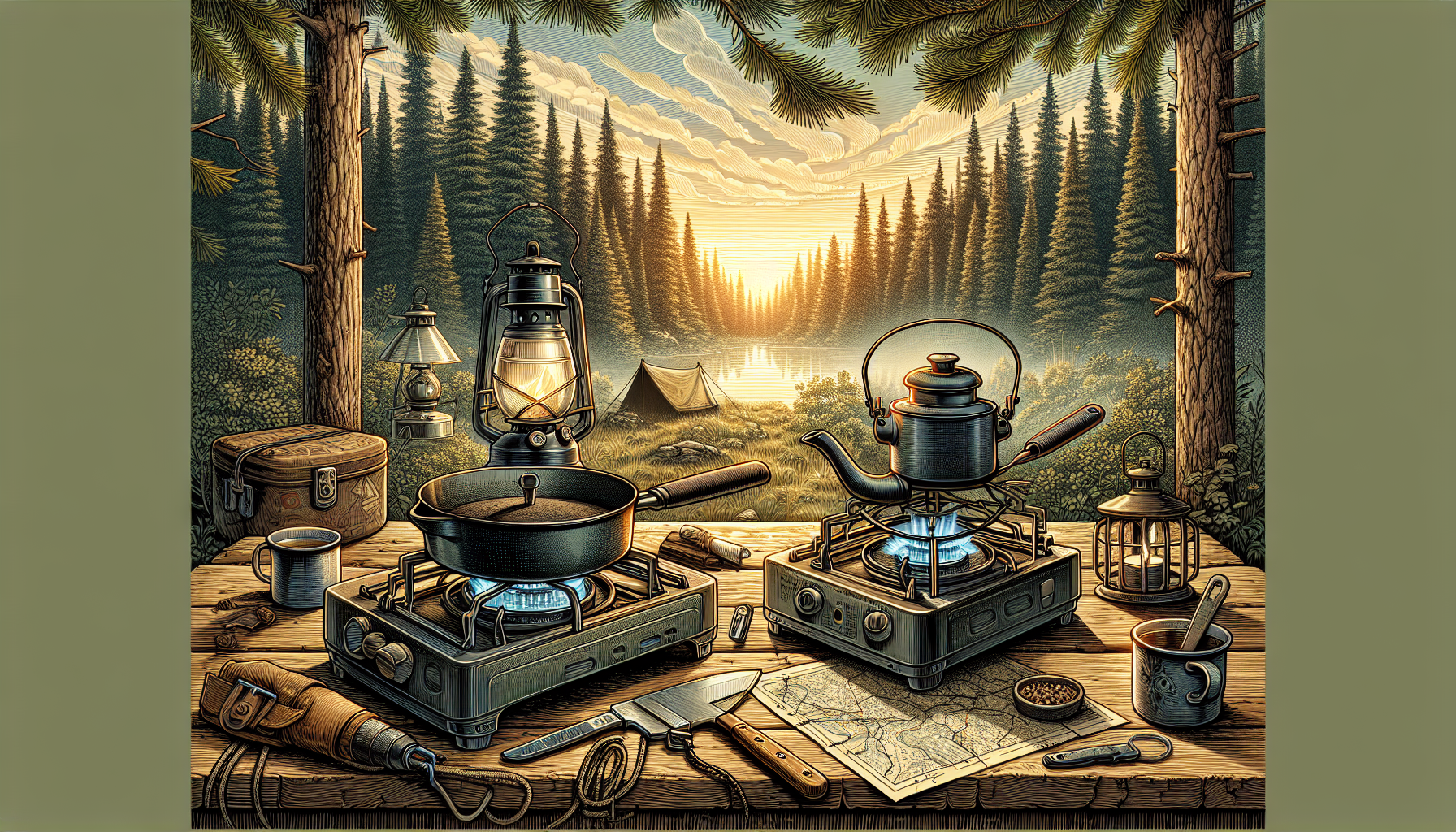The Ultimate Guide to Camping Stoves: A Comprehensive Look at Outdoor Cooking Essentials
When it comes to camping, one of the most important considerations is how you’re going to cook your meals. While traditional campfires have their charm, they are not always practical or allowed in certain areas. This is where camping stoves come in compact, portable, and efficient, these handy devices have revolutionized outdoor cooking and made it easier for adventurers to enjoy hot meals even in the most remote locations.
The Evolution of Camping Stoves
Camping stoves have come a long way since their inception. The earliest versions of portable stoves were simple, lightweight designs that used solid fuel tablets or alcohol burners to heat food. Over time, advancements in technology have led to the development of more sophisticated camping stoves that can run on a variety of fuels, including propane, butane, and even electricity.
One of the key milestones in the evolution of camping stoves was the introduction of the liquid fuel stove in the early 20th century. These stoves were more efficient and powerful than their predecessors, making them popular among outdoor enthusiasts. Today, camping stoves come in a wide range of designs, from compact backpacking stoves to larger, multi-burner models suitable for group camping trips.
Types of Camping Stoves
There are several types of camping stoves available on the market, each with its own set of pros and cons. Understanding the differences between these types can help you choose the right stove for your needs.
1. Canister Stoves
Canister stoves are among the most popular types of camping stoves due to their convenience and ease of use. These stoves use pressurized fuel canisters that contain a mix of propane and butane, making them ideal for quick meals and boiling water. Canister stoves are lightweight, compact, and easy to set up, making them a favorite among backpackers and solo campers.

2. Liquid Fuel Stoves
Liquid fuel stoves, also known as white gas stoves, are versatile and reliable options for camping. These stoves run on liquid fuels such as white gas, kerosene, or unleaded gasoline, making them suitable for use in a wide range of temperatures and altitudes. Liquid fuel stoves are highly efficient and can be used for cooking more elaborate meals, making them a popular choice for group camping trips.

3. Wood Burning Stoves
Wood burning stoves are eco-friendly options for campers who prefer to cook with natural resources. These stoves utilize twigs, sticks, and other biomass materials as fuel, eliminating the need to carry gas canisters or liquid fuel. Wood burning stoves can be a bit more challenging to use than other types of camping stoves, as they require constant feeding and monitoring of the fire. However, they are a sustainable and cost-effective choice for outdoor cooking.

4. Multi-Fuel Stoves
Multi-fuel stoves are versatile options that can run on a variety of fuels, including canister gas, liquid fuel, and even wood. These stoves offer the flexibility to adapt to different camping conditions and fuel availability, making them a popular choice for adventurous campers who travel to remote locations. While multi-fuel stoves tend to be heavier and more expensive than other types of camping stoves, their versatility and reliability make them a worthwhile investment for serious outdoor enthusiasts.
Choosing the Right Camping Stove
When selecting a camping stove, there are several factors to consider to ensure you choose the right one for your needs:
1. Fuel Type
Consider the type of fuel you prefer to use and the availability of that fuel in your camping area. Some fuels are more efficient than others, while others may be more environmentally friendly. Choose a stove that runs on a fuel that suits your preferences and camping conditions.
2. Size and Weight
Portability is key when it comes to camping stoves, especially if you plan to hike or backpack with your stove. Look for lightweight, compact stoves that are easy to carry and set up, without compromising on cooking power or functionality.
3. Cooking Capacity
Determine how many people you plan to cook for and the types of meals you want to prepare. Some camping stoves are designed for solo campers, while others can accommodate larger groups. Choose a stove with the right cooking capacity to meet your needs.
4. Simplicity of Use
Consider how easy the stove is to set up, light, and maintain. Look for stoves with simple, intuitive designs that are user-friendly, especially if you are new to camping or outdoor cooking.
5. Durability and Reliability
Invest in a high-quality camping stove that is built to last and can withstand the rigors of outdoor use. Look for stoves made from durable materials that are resistant to rust, corrosion, and heat damage, ensuring your stove will perform reliably trip after trip.
6. Price
Set a budget for your camping stove purchase and compare the features and capabilities of different models within your price range. While it can be tempting to opt for the most expensive stove on the market, there are plenty of affordable options that offer excellent performance and value.
Expert Opinions
We reached out to outdoor experts and camping enthusiasts to get their take on camping stoves and what sets them apart. Here’s what they had to say:
“When it comes to choosing a camping stove, versatility is key. I recommend investing in a multi-fuel stove that can adapt to different camping conditions and fuel sources. This way, you’ll always have a reliable cooking solution no matter where your adventures take you.” Sarah, Outdoor Enthusiast
“I prefer canister stoves for their convenience and ease of use. Whether I’m backpacking solo or camping with friends, my canister stove never lets me down. It’s lightweight, compact, and boils water in minutes perfect for quick meals on the trail.” John, Backpacker
Common Misconceptions
There are several misconceptions surrounding camping stoves that can confuse or mislead consumers. Let’s debunk some of the most common myths:
Myth: Camping stoves are only for avid outdoorsmen.
Fact: Camping stoves are versatile cooking tools that can be used by anyone, from casual campers to serious backpackers. Whether you’re cooking in your backyard or out in the wilderness, a camping stove can make meal preparation quick and easy.
Myth: All camping stoves are the same.
Fact: There are many different types of camping stoves available, each with its own features and capabilities. It’s important to choose a stove that meets your specific needs and camping style to ensure a successful outdoor cooking experience.
FAQs
Q: Do I need a camping stove for my outdoor adventures?
A: While you can certainly cook over an open fire, a camping stove offers greater control, efficiency, and convenience when it comes to outdoor cooking. Whether you’re heating up a cup of coffee or cooking a full meal, a camping stove can make the experience more enjoyable and hassle-free.
Q: Are camping stoves safe to use?
A: When used properly and according to the manufacturer’s instructions, camping stoves are safe to use. It’s important to set up your stove on a stable, level surface away from any flammable materials and to never leave it unattended while in use. Always follow safety guidelines and precautions to prevent accidents and injuries.
To Wrap Things Up
Camping stoves are essential tools for outdoor enthusiasts who enjoy cooking and eating in the great outdoors. Whether you’re embarking on a solo adventure or camping with friends and family, a camping stove can make meal preparation a breeze. By choosing the right stove for your needs and following safety guidelines, you can enjoy delicious, hot meals no matter where your outdoor adventures take you.




